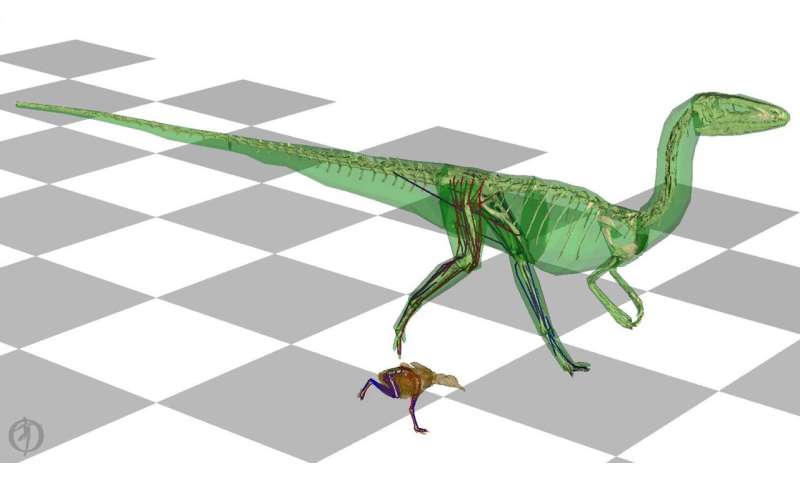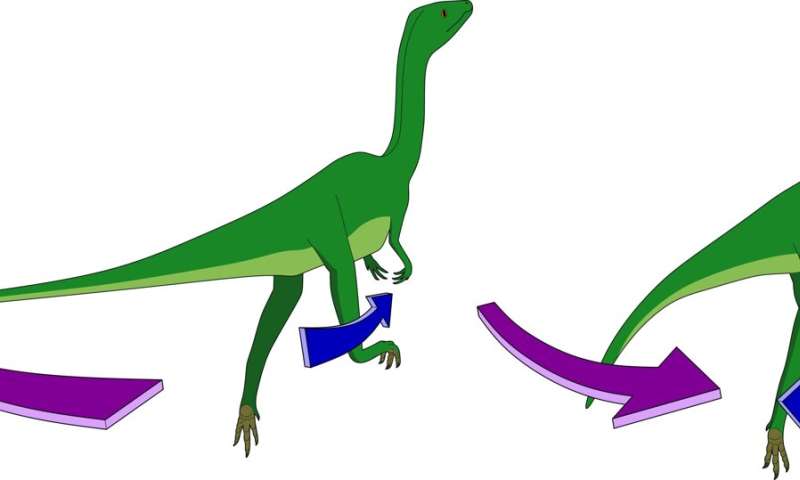September 23, 2021 report
Simulations show bipedal dinosaurs swung their tails as they ran to help with balance

An international team of researchers has found it likely that bipedal dinosaurs swung their tails as they walked and ran to maintain their balance. In their paper published in the journal Science Advances, the group describes computer simulations visualizing how the dinosaur Coelophysis bauri likely used its tail during locomotion.
Prior research has suggested that the long, heavy tails sported by dinosaurs served mainly to counterbalance their long necks and heavy heads. In this new effort, the researchers have found evidence that suggests that the tail also was used to help with balance.
To learn more about the role of the tail in locomotion, the researchers used recently developed 3D simulation technology, which are based on computational biomechanics and have been used in a wide variety of applications. The researchers began by developing a generic muscle-driven therapod dinosaur framework, which they tested by simulating the gait of a modern tinamous bird—one that tends to walk much more than fly. After finding their simulation matched closely with the real bird, the researchers turned their attention to Coelophysis bauri—a relatively small Triassic species. After inputting its known characteristics, the researchers ran the simulation and watched as the dinosaur was put through its paces.
The researchers found that the dinosaur swung its tail back and forth as it ran or walked in harmony with its neck, creating a rhythmic pattern. A close look showed that the dinosaur was using its tail to regulate the angular momentum throughout its entire body along an axis to maintain its balance. They noted that the swinging pattern of the tail resembled that of humans walking or running as they swing their arms.
The researchers also changed the size of the tail in the simulations to see how it might impact the creature's locomotion, and in one case, removed it altogether. They found that doing so forced the dinosaur to exert more energy as it moved—without the tail, it used 18% more muscle power. They suggest it is likely that other dinosaurs used their tails in similar ways.
-

Computer simulations of running locomotion in a modern tinamou bird (brown) and extinct theropod dinosaur Coelophysis (green). Grey tiles = 50 cm. Credit: Bishop et al., Sci. Adv. 2021; 7: eabi7348 -

Stylistic demonstration of the study’s main finding: the tail of bipedal dinosaurs like Coelophysis laterally flexed (wagged) in sync with the forwards–backwards swinging of the hindlimbs. As the left hindlimb was retracted backwards, the tail flexed to the left, and vice versa for the right hindlimb. Credit: Bishop et al., Sci. Adv. 2021; 7: eabi7348
More information: Peter J. Bishop et al, Predictive simulations of running gait reveal a critical dynamic role for the tail in bipedal dinosaur locomotion, Science Advances (2021). DOI: 10.1126/sciadv.abi7348
Journal information: Science Advances
Provided by Science X Network
© 2021 Science X Network





















